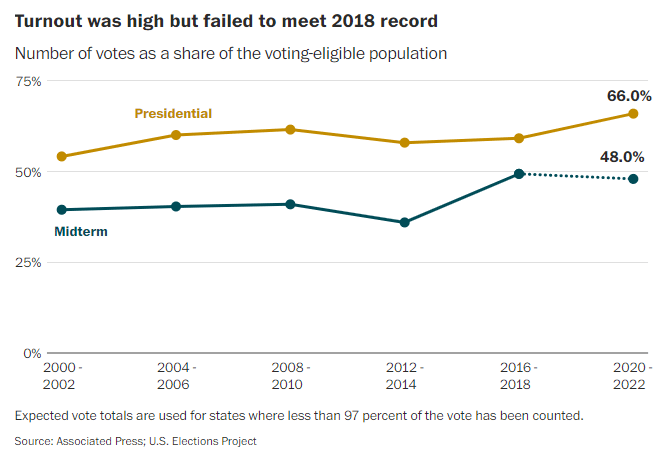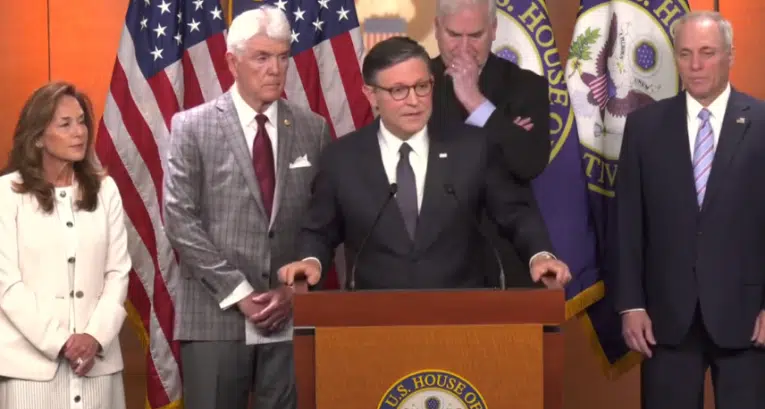
18-29-year-olds had increased enthusiasm to vote on Nov. 8, and 65-year-olds had decreased enthusiasm, weekly Economist/YouGov surveys ahead of the 2022 U.S. Congressional midterms show.
After the Supreme Court overturned Roe v. Wade decision, younger voter interest in the race for Congress visibly increased. 18-29-year-olds went from 24 percent definitely voting right before the decision to 27 percent right after, according to June, July and October Economist/YouGov’s registered voters polls. That was also the same week Republicans went from a 5-point lead on registered voters to a 3-point deficit in the surveys.
By the end of the race, the last Economist/YouGov generic ballot poll had 18-29-year-olds definitely voting number all the way up to 39 percent by Election Day.
In the meantime, 65-year-old-and-older voters definitely voting went from 81 percent, up to 85 percent, and then down to 58 percent right before the election.
As a result, turnout in 2022 at 48 percent looked a lot more like 2018’s 50.3 percent than 2010 or 2014, the latter of which had 40.9 percent and 36.7 percent, according to an AP/Election Project analysis by the Washington Post. The two red wave midterm elections of 2010 and 2014 tended to have lower percentage turnout than the 2018 blue wave that netted 41 seats for Democrats.

2014 and 2010 with the lowest turnout netted the highest number of Republican seats: 247 and 242, respectively. 2018 and 2022 with the highest turnout netted the lowest numbers of Republican seats, at 199 and something approaching 222 or so seats in the House, give or take a few when all the counting, recounts and various election contests in 2022 are concluded.
According to the AP/Election analysis, the increased turnout was concentrated in states with important, competitive statewide races, owing to the third of Senate seats that are up every two years, plus whatever governors’ races, turnout will be higher in those particular states.
2018 was also an exceptional midterm, where the GOP actually netted two seats in the Senate on former President Donald Trump’s coattails instead of losing seats as Republicans focused much of their resources on taking Senate seats. Certainly, boosted Republican turnout in those states would have increased overall voter participation in the midterms
And yet, even in states with lower turnout, Democrats managed to lose very few seats. So, something besides turnout was causal in determining the GOP’s seeming inability to pick up more House seats.
The reelection rate for U.S. House incumbents in 2022 so far is about 94.5 percent as of the time of this writing, according to Open Secrets, compared with 91 percent in 2018 and 85 percent in 2010 when control of the House changed hands in big sweeps.
Fortunately for Republicans, inflation and the economy still had an edge in almost every survey taken ahead of the midterms, consistently outpacing abortion as an often distant second, with increased importance for abortion as the top issue for younger voters.
Among 18-to-29-year-olds in the Economist/YouGov survey in July, immediately following the Supreme Court’s action, 8 percent said abortion was their most important issue. In October, right before the election, that number was up to 12 percent, something Democrats were able to increasingly take advantage of throughout the year. Boosting turnout in this category almost certainly offset what would have been even bigger losses for Democrats.
But diminished enthusiasm among seniors must also be factored in. Over the summer, seniors were extremely interested in voting, but less so come October. Why?
Perhaps that was what President Joe Biden’s cynical attack on former President Donald Trump and Make America Great Again (MAGA) Republicans was all about, including the FBI raid on Trump’s Mar-a-Lago residence in August and the conviction of former 2016 Trump campaign CEO Steve Bannon on ridiculous Congressional subpoena process crimes, suggesting his political opponents were enemies of the state, effectively demonizing, dehumanizing and even criminalizing their existence using the bully pulpit. Simply put, that is designed to diminish turnout of Trump voters, who tend to be older.
It worked, but only to a certain extent. Biden is like almost every other U.S. President in modern history who lost seats in his first term of office. But with the higher than usual reelection rate for Democrats, Biden could have had at least some coattails, protecting more seats than expected with his political strategy.
The question of whether it will work again might be answered by none other than former President Trump should he decide to run again, a presidential nominating contest that would almost certainly favor him.
But 2024 will look a lot more like 2018 in terms of favoring Democratic turnout as is common when presidents run for reelection, as blue states refine their early voting even further. Republicans will definitely need to be united to minimize their losses or even pull off an upset.
2024 is by all means still up for grabs. Past performance never fully guarantees future returns. The economy and inflation don’t appear to be going anywhere for the time being, and once inflation does go down, unemployment has historically ticked upward as the economy overheated. All that unemployment is still on the horizon, and concerns over prices today could spill over into the worst-case scenario for a President running for reelection and that’s more voters looking for jobs.
The last three incumbent presidents all ousted — Jimmy Carter, George H.W. Bush and Donald Trump — all had one thing in common: recessions with hundreds of thousands or even millions of jobs lost. Time will tell how bad the current Covid-led production slowdown and supply crisis, labor shortages and the $6 trillion printed for Covid still sloshing around the economy are at first continuing the inflation, and then curing it as demand collapses and job losses rise. Biden might have been better off had the entire recession come immediately. We’ll see. Stay tuned.
Robert Romano is the Vice President of Public Policy at Americans for Limited Government.





